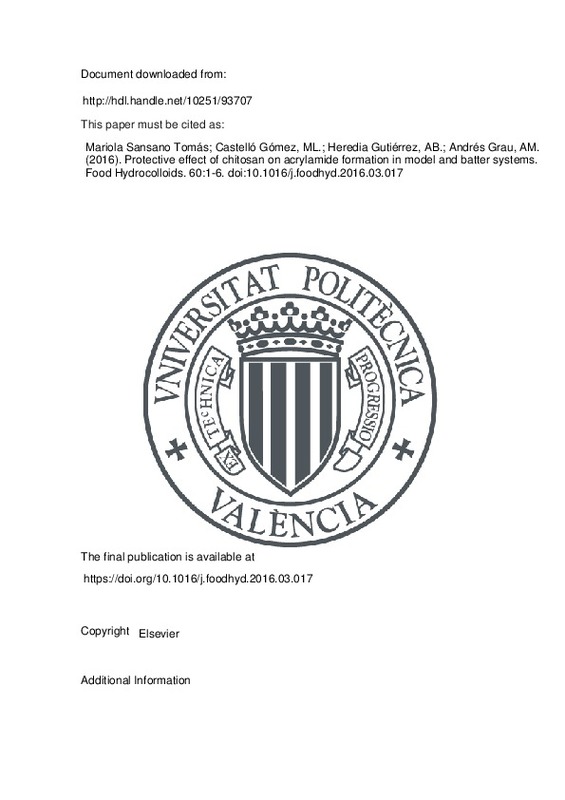JavaScript is disabled for your browser. Some features of this site may not work without it.
Buscar en RiuNet
Listar
Mi cuenta
Estadísticas
Ayuda RiuNet
Admin. UPV
Protective effect of chitosan on acrylamide formation in model and batter systems
Mostrar el registro sencillo del ítem
Ficheros en el ítem
| dc.contributor.author | Sansano Tomás, Mariola
|
es_ES |
| dc.contributor.author | Castelló Gómez, María Luisa
|
es_ES |
| dc.contributor.author | Heredia Gutiérrez, Ana Belén
|
es_ES |
| dc.contributor.author | Andrés Grau, Ana María
|
es_ES |
| dc.date.accessioned | 2018-01-02T09:39:30Z | |
| dc.date.available | 2018-01-02T09:39:30Z | |
| dc.date.issued | 2016 | es_ES |
| dc.identifier.issn | 0268-005X | es_ES |
| dc.identifier.uri | http://hdl.handle.net/10251/93707 | |
| dc.description.abstract | [EN] In recent years high contents of acrylamide, a potentially carcinogenic substance, have been found in a wide range of fried and baked foods. For this reason, the health authorities together with the food industry have carried out research to find ways to minimize the presence of acrylamide during food processing. The addition of chitosan may be an excellent alternative for achieving this goal because due to their richness in amino groups, they would interfere with the Maillard reaction that unleashes the formation of acrylamide. The main aims of this study were to analyze the addition of different concentrations of chitosan in model systems as a new way of mitigating generation of acrylamide during frying processes, while evaluating the influence of pH, reducing sugars (glucose and fructose) present in the system and frying temperature, and to determine the functionality of adding chitosan in fried batter systems. The results showed that chitosan is capable of inhibiting the formation of acrylamide in model systems and in fried batters. In model systems, a reduction in acrylamide ranging from 49 to 85% was achieved for 1% of chitosan, the maximum inhibition taking place in asparagine-fructose model systems and the lowest in asparagineeglucose model systems. In fried batter, acrylamide was mitigated by 59 ± 6% with a chitosan concentration of 0.27% in batter formulations. Double concentrations of chitosan (0.54%) did not considerably improve the inhibition capacity. | es_ES |
| dc.description.sponsorship | The authors would like to thank the Generalitat Valenciana (GV/2012/072) for the financial support given to this investigation. | |
| dc.language | Inglés | es_ES |
| dc.publisher | Elsevier | es_ES |
| dc.relation.ispartof | Food Hydrocolloids | es_ES |
| dc.rights | Reserva de todos los derechos | es_ES |
| dc.subject | Acrylamide | es_ES |
| dc.subject | Chitosan | es_ES |
| dc.subject | Model systems | es_ES |
| dc.subject | Batter systems | es_ES |
| dc.subject.classification | TECNOLOGIA DE ALIMENTOS | es_ES |
| dc.title | Protective effect of chitosan on acrylamide formation in model and batter systems | es_ES |
| dc.type | Artículo | es_ES |
| dc.identifier.doi | 10.1016/j.foodhyd.2016.03.017 | es_ES |
| dc.relation.projectID | info:eu-repo/grantAgreement/GVA//GV%2F2012%2F072/ | |
| dc.rights.accessRights | Abierto | es_ES |
| dc.contributor.affiliation | Universitat Politècnica de València. Departamento de Tecnología de Alimentos - Departament de Tecnologia d'Aliments | es_ES |
| dc.contributor.affiliation | Universitat Politècnica de València. Instituto Universitario de Ingeniería de Alimentos para el Desarrollo - Institut Universitari d'Enginyeria d'Aliments per al Desenvolupament | es_ES |
| dc.description.bibliographicCitation | Sansano Tomás, M.; Castelló Gómez, ML.; Heredia Gutiérrez, AB.; Andrés Grau, AM. (2016). Protective effect of chitosan on acrylamide formation in model and batter systems. Food Hydrocolloids. 60:1-6. https://doi.org/10.1016/j.foodhyd.2016.03.017 | es_ES |
| dc.description.accrualMethod | S | es_ES |
| dc.relation.publisherversion | https://doi.org/10.1016/j.foodhyd.2016.03.017 | es_ES |
| dc.description.upvformatpinicio | 1 | es_ES |
| dc.description.upvformatpfin | 6 | es_ES |
| dc.type.version | info:eu-repo/semantics/publishedVersion | es_ES |
| dc.description.volume | 60 | es_ES |
| dc.relation.pasarela | S\304709 | es_ES |
| dc.contributor.funder | Generalitat Valenciana | es_ES |







![[Cerrado]](/themes/UPV/images/candado.png)

